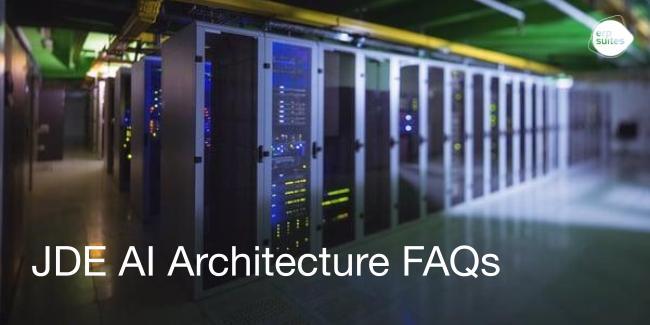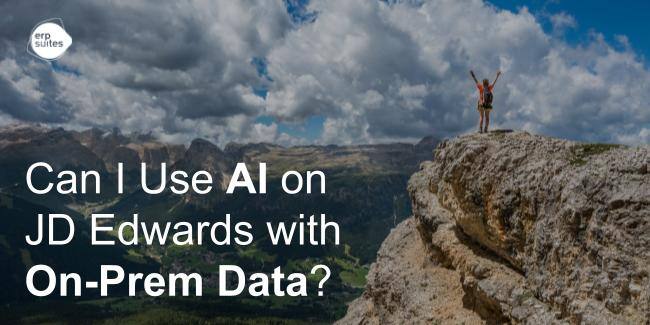6 Common Myths About IBM i in 2025
November 15th, 2024
5 min read
.png?width=960&height=540&name=Blog%20Images%20(76).png)
The end of the year is coming up fast. Budgets are being hammered out. You’re evaluating whether or when to upgrade your JDE release to keep your ERP system in tip-top shape. You’re wondering if you need to do the same with your IBM i. Will it keep working with JDE? Is IBM i going to become obsolete?
In a word, no. You can take a deep breath; the IBM I isn’t going anywhere.
This powerful combination of operating system and database has been around in varying iterations since 1978. JD Edwards has a longstanding history of compatibility with the IBM i, and that’s not going anywhere for the foreseeable future. Our ERP Suites team has many decades of JD Edwards experience, and have helped many clients smoothly navigate upgrades of all kinds.
We’ll dive into 6 common myths about IBM i, why they’re not true, and why the IBM i can still work for you.
Myth 1: The IBM i is Outdated and Needs to Be Replaced
While the IBM i can still run code written back in the 1980s, this does not mean that the IBM i technology itself is outdated. As evidenced by its three iterations thus far – System/38, AS/400, and IBM i – there is still a lot of mileage left in this legacy OS.
Over the years, IBM has continually incorporated new technologies that provide support for new features and functionalities. IBM routinely releases roadmaps that detail the future of its products. The latest IBM I roadmap takes it beyond 2030. There are no plans to end the IBM i system, especially not when you consider that over 100,000 companies still operate on the AS/400 technology.
And thanks to IBM i’s usage of IBM Power technology, its performance levels are exponentially higher than others on the market. This means IBM i remains a viable, competitive option for new and current users alike.
Verdict: False. The IBM i can hold its own in the modern operating system marketplace and continue to integrate with JDE.
Myth 2: IBM i Can't Integrate with Cloud Solutions
It’s true that IBM i is a self-contained system, with a uniquely combined operating system and database architecture. It’s also true that IBM i is a legacy system. But that does not mean it can’t integrate with modern cloud solutions. IBM has continuously updated the platform to enable cloud compatibility.
The root of this misconception really comes from the fact that certain cloud environments don’t run IBM i themselves. Take AWS or Azure for example. While these platforms don’t run IBM i directly, they do partner with other third-party companies so that they can have IBM i within their data centers. IBM i can also run within the IBM Cloud itself.
Verdict: False. It is possible to run IBM i in a cloud environment, with or without a third-party solution. It just depends on the cloud platform provider.
Myth 3: IBM i Is Expensive Compared to Modern Alternatives
The total cost of ownership for any operating system and/or database boils down to these essentials: hardware, licensing, labor, and maintenance. The IBM i is no exception. It requires robust, enterprise-grade hardware, has its own licensing model, requires specialized skills, and needs to be maintained just like any other system.
The IBM i stands apart thanks to the Power processor and its use of cores. This is what runs IBM i workloads. Each processor has multiple cores, or processing units, for a total core count. Licensing costs for most systems like IBM i are tied to the core count. Unlike various competitors, the Power Processor uses less cores.
Take for example a customer has EnterpriseOne licensing, which is charged per core. This customer runs a certain database on an Intel Core, and it takes 64 cores to run a specific application. If they ran the same thing on an IBM i, it would only require 16 cores. The customer ends up with a quarter of the cost for that Oracle licensing, because the Power processor has such a higher performance compared to other competitors.
Labor costs are also lessened because a database administrator (DBA) is not needed. Because the IBM i combines its database with its operating system, the customer won’t have that additional DBA cost.
Verdict: False. The total cost of ownership for IBM i is comparable to other modern databases and operating systems.
Myth 4: IBM i Skills Are Hard to Find, Making It a Risky Investment
It’s no secret the workforce that grew up professionally with IBM i is retiring. But that doesn’t mean there aren’t a) folks who can step into their shoes and b) alternative solutions.
While IBM i code was originally written in RPG, IBM has enhanced the system to support newer programming languages, like Python.
Let’s say a customer is hiring someone out of college as a programmer. No colleges teach RPG anymore, but that won’t be an issue for this customer. Their IBM i has already been enhanced with the new programming languages. All they need to do is teach their new programmer the ins and outs of programming Python to the back-end of IBM i.
Administration of IBM i is a slightly different story. That’s one manual task that can’t be solved through enhancements. However, companies are starting to train individuals for these kinds of roles. Here at ERP Suites, we train for administrative tech roles, especially because the hardware has evolved over time.
In the past, IBM i was a standalone system that ran one partition, due to the amount of processing power available. Today, because there is so much more power available, we’re seeing numbers like 20, 30, 40 or more partitions on one physical system. As such, the number of administrators to manage that expanded load has increased as well. This is why ERP Suites offers IBM i managed services, and certainly why other providers do, too.
Verdict: False. The current workforce can still administer and code within the parameters of the modernized IBM i system.
Myth 5: JD Edwards Won't Be Supported on IBM i Long-Term
There was a time when it was feared that Oracle, JD Edwards’ parent company, would not continue to support the IBM i platform. But this requires a bit of time travel to get the full story.
Before JDE’s EnterpriseOne, there was JD Edwards World. This solution was built to run specifically on IBM i. It was designed specifically for IBM’s proprietary hardware and OS, and used IBM’s RPG programming language. It is often referred to as a “green screen” application because of its green-screen and text-based interface.
Roughly a decade ago, Oracle announced it would end support for JD Edwards World. But when they realized how many customers still run that specific application, Oracle elected to take a phased transition approach. JD Edwards World is currently in an extended support phase, and will move to sustaining support in May 2025. This means Oracle provides critical patches and fixes, but no new features or enhancements.
It is because of this that many customers feared that running JDE on IBM i would no longer be possible. However, there is no end date set for sustaining support and there are no plans to sunset anyone on IBM i.
Verdict: False. While premier support for JD Edwards World on IBM i has ended, it still has sustaining support from Oracle. EnterpriseOne remains supported on IBM i without limitations.
Myth 6: JD Edwards Can't Run as Effectively or Securely on IBM i
Running JD Edwards EnterpriseOne (E1) requires specific infrastructure and software to ensure optimal performance, security, and compatibility. IBM i offers all that and more. Because IBM i’s uptime rate is so high, and because of its combined database and operating system, it is more stable to run E1 on IBM i than any other platform. IBM i’s intra-hardware performs better than other platforms, making it the best back-end server for E1.
Over the years, IBM continues to increase the amount of flexibility for implementing layers of security that customers need. For example, take row level security. A user could walk down one specific field in a database field, so only specific users could see sensitive data like a social security number or credit card number. That additional security built directly into the operating system enhances any other security measures customers might employ.
Verdict: False. IBM i's patented database and operating system combo actually affords more security and better performance for E1 users.
IBM i Remains a Solid Choice for 2025 and Beyond
While the IBM i technology came out over 40 years ago, it has continued to evolve with the times. The system’s many enhancements over the years allow it to be a viable and competitive player on the field in 2025.
IBM i remains a cost-effective solution that integrates well with the increasing cloud technologies customers are seeking and works with existing ERP solutions like JD Edwards EnterpriseOne for effective, efficient and optimized operations.
Want to entrust your IBM i to professionals with decades of IBM i expertise? Read about our IBM i managed services.
Leyla Shokoohe is an award-winning journalist with over a decade of experience, specializing in workplace and journalistic storytelling and marketing. As content manager at ERP Suites, she writes articles that help customers understand every step of their individual ERP journey.
Topics:



.png?width=650&height=325&name=Blog%20Images%202_1%20(4).png)
.png?width=650&height=325&name=Blog%20Images%202_1%20(5).png)
.png?width=650&height=325&name=Blog%20Images%202_1%20(3).png)
.png?width=650&height=325&name=Blog%20Images%202_1%20(2).png)
.png?width=650&height=325&name=Blog%20Images%202_1%20(1).png)
.png?width=960&height=540&name=Blog%20Images%20(96).png)

.png?width=960&height=540&name=Blog%20Images%20(90).png)
.png?width=960&height=540&name=Blog%20Images%20(88).png)
.png?width=960&height=540&name=Blog%20Images%20(87).png)
.png?width=960&height=540&name=Blog%20Images%20(86).png)
.png?width=960&height=540&name=Blog%20Images%20(85).png)
.png?width=960&height=540&name=Blog%20Images%20(83).png)
.png?width=960&height=540&name=Blog%20Images%20(82).png)
.png?width=960&height=540&name=Blog%20Images%20(80).png)